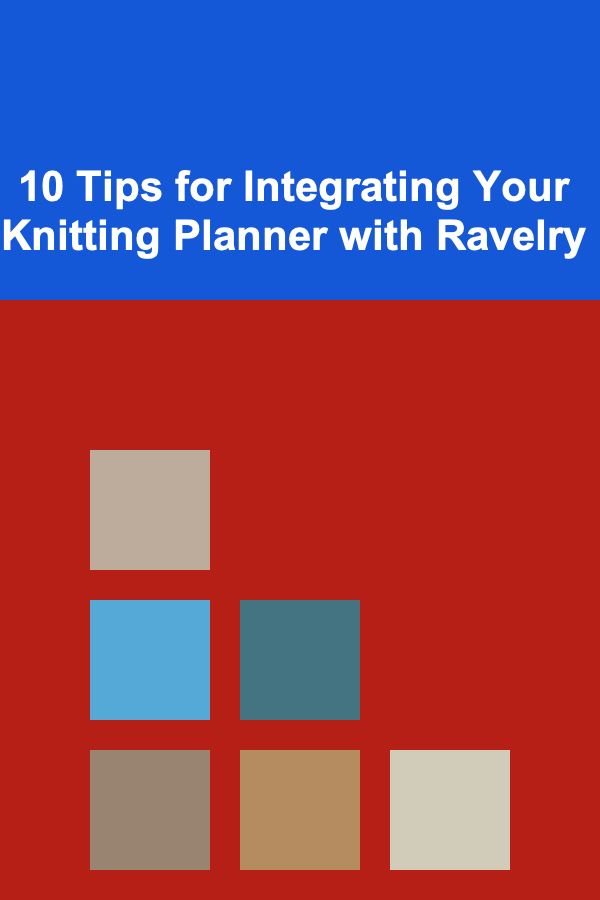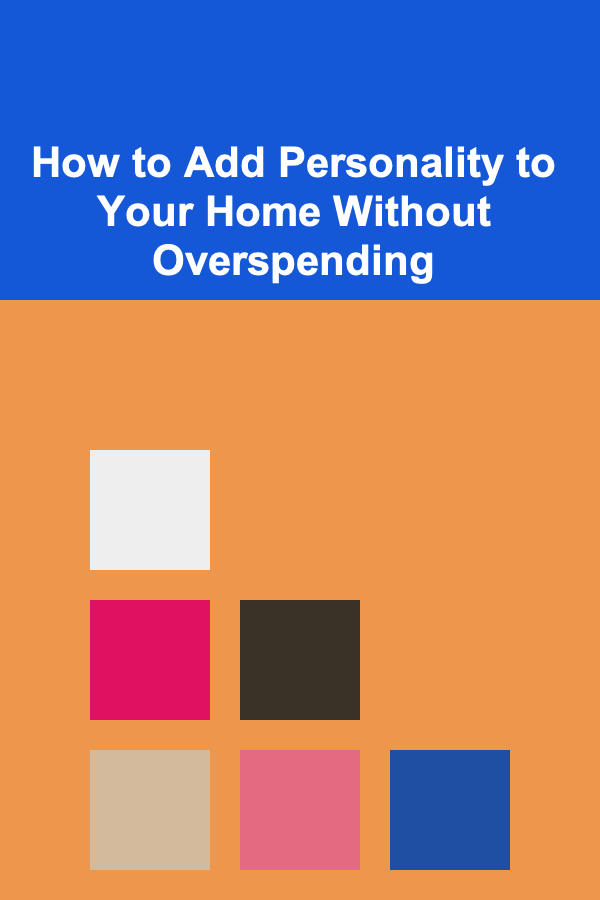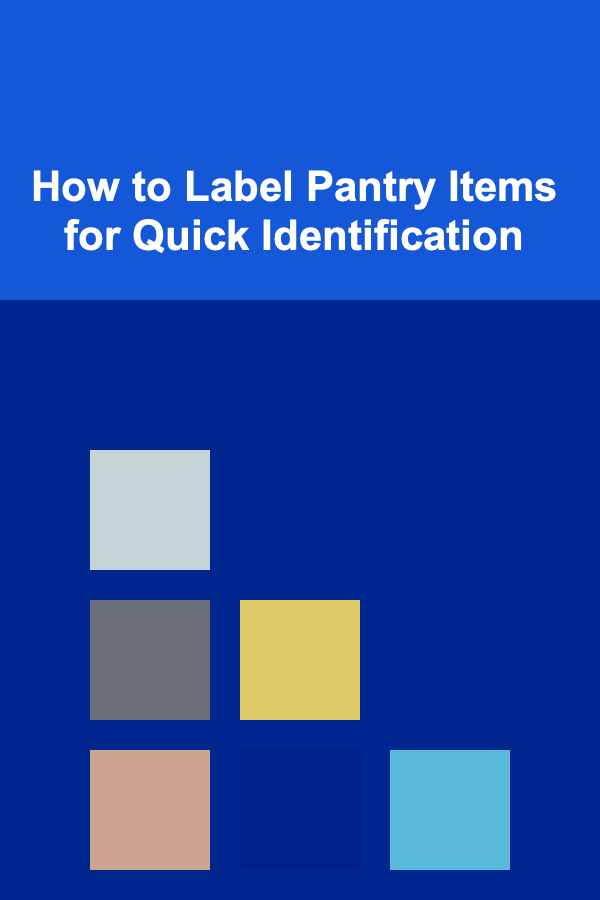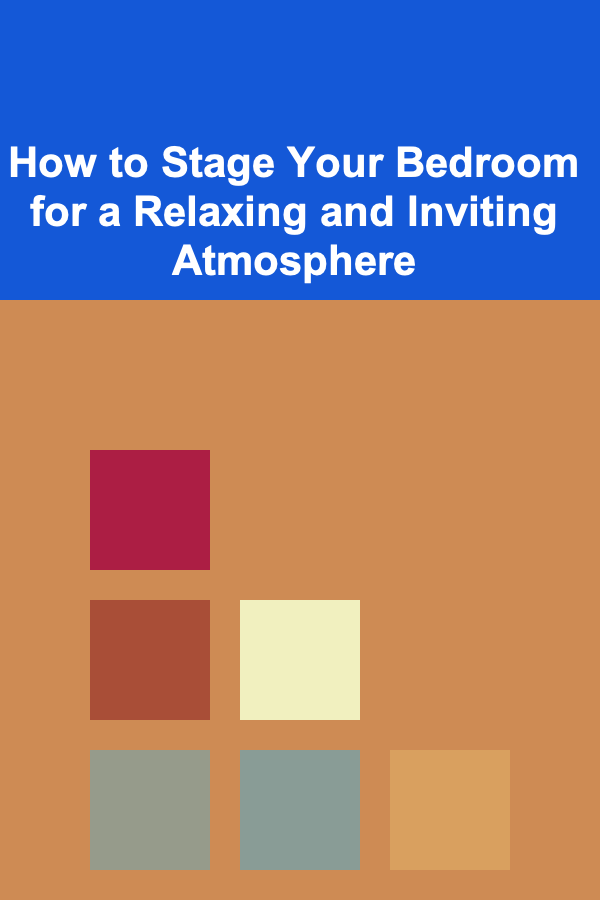
10 Tips for Integrating Your Knitting Planner with Ravelry
ebook include PDF & Audio bundle (Micro Guide)
$12.99$8.99
Limited Time Offer! Order within the next:

Knitting is more than just a hobby for many --- it's a form of creative expression, a way to relax, and sometimes even a way to connect with a larger community of fellow enthusiasts. As knitting continues to grow in popularity, so do the tools available to support knitters in their craft. One of the most popular platforms for knitters is Ravelry, a website that serves as both a community and a massive database for knitting patterns, projects, and resources.
For knitters who want to keep track of their projects, yarns, patterns, and progress, a knitting planner is often an essential tool. Integrating your knitting planner with Ravelry can help streamline your creative process, keep you organized, and provide a seamless experience that enhances your knitting journey.
In this article, we will explore 10 valuable tips for integrating your knitting planner with Ravelry. These tips will help you make the most of both tools, ensuring that your knitting projects are well-organized, your progress is easily tracked, and your experience as a knitter is enhanced.
Sync Your Project List Between Your Planner and Ravelry
One of the first steps to creating a seamless connection between your knitting planner and Ravelry is to sync your project list. Many knitting planners allow you to input and track your ongoing projects, and Ravelry provides an excellent platform for documenting your projects, including pattern details, yarn used, and your progress.
How to Sync:
- Start by adding your current and upcoming knitting projects to your planner. For each project, make sure to include details such as the pattern name, designer, yarn, and any other notes that help you stay organized.
- On Ravelry, ensure that your projects are properly listed and that each one includes detailed information such as the start date, the pattern, and any adjustments or notes you've made.
- If your knitting planner allows for direct integration, enable it to sync your project list with Ravelry automatically. If manual entry is necessary, regularly update both platforms to keep them consistent.
Benefit:
This integration ensures that you have a clear overview of all your knitting projects, with up-to-date information on both platforms.
Use Ravelry's Pattern Search to Discover New Ideas for Your Planner
Ravelry is a treasure trove of knitting patterns. Whether you're looking for a specific type of sweater, shawl, or accessory, Ravelry's pattern database allows you to search through thousands of designs. Once you've discovered patterns that interest you, you can easily add them to your knitting planner to stay on top of your future projects.
How to Sync:
- Browse the patterns section on Ravelry and bookmark or save the ones you're interested in.
- In your knitting planner, create a section specifically for future projects. Add the patterns you've discovered on Ravelry, along with any relevant details like yarn requirements and deadlines.
- If your knitting planner allows you to include links, paste the Ravelry link to the pattern so you can easily access it later.
Benefit:
Using Ravelry's vast pattern database gives you endless inspiration, while your planner helps you organize these ideas and plan your knitting timeline.
Link Your Ravelry Stash to Your Planner's Yarn Inventory
A key component of any knitting planner is tracking your yarn stash. Ravelry offers a comprehensive yarn database, where you can record every skein of yarn in your collection. By integrating this database with your planner, you can easily see what yarns you have available and avoid overbuying or forgetting about unused skeins.
How to Sync:
- On Ravelry, update your yarn stash regularly, including details like the fiber content, colorway, yardage, and quantity of each skein.
- In your knitting planner, create an inventory section where you can record the same details, or if your planner offers digital integration, connect it to your Ravelry stash directly.
- Use your planner to map out which yarns will work best for specific projects, linking directly to the Ravelry stash entries.
Benefit:
This integration allows you to efficiently manage your yarn collection, ensuring that you make the best use of your materials and preventing waste.
Track Your Knitting Progress with Project Photos on Ravelry
One of the best features of Ravelry is its ability to visually document knitting projects through photos. As you work on a project, you can upload photos of your progress to Ravelry, creating a visual timeline. This helps you stay motivated and also allows you to see how far you've come.
How to Sync:
- As you make progress on a project, upload photos to the corresponding project page on Ravelry.
- In your knitting planner, make a note of when you plan to take progress photos, or set reminders to update your Ravelry page with new images.
- If your planner has an app or digital integration, link your project directly to the photos on Ravelry so you can access them easily.
Benefit:
Being able to visually track your progress keeps you motivated and provides a sense of accomplishment. It also allows you to reflect on your knitting journey over time.
Set Knitting Goals and Deadlines Using Both Platforms
If you're working on multiple projects or have specific knitting goals, it can be easy to lose track of deadlines and milestones. Both your knitting planner and Ravelry can help you stay on top of deadlines by setting specific goals for each project.
How to Sync:
- In your knitting planner, set goals for each project, such as completion dates, specific milestones (e.g., finish the cuff, complete the body), and any other objectives.
- On Ravelry, use the "project notes" section to outline your timeline for each project, including deadlines for finishing specific stages.
- Sync reminders between both platforms to help you stay accountable and on schedule.
Benefit:
Having clear goals and deadlines can help you manage your time effectively and ensure that your projects are completed on time.
Use Ravelry's Forum and Community to Stay Inspired
Knitting is often a social activity, and one of the best ways to stay engaged is by participating in online communities. Ravelry has an active forum where knitters from around the world share advice, tips, and inspiration. By incorporating this community aspect into your knitting planner, you can stay motivated and inspired.
How to Sync:
- Set aside time in your knitting planner for exploring Ravelry's forums and discussion groups. Use these sessions to gain new insights, discover new patterns, or connect with other knitters.
- You can even plan specific projects around challenges or KALs (Knit-A-Longs) you find in the community.
Benefit:
The sense of community and shared knowledge from Ravelry's forums can inspire creativity and provide support during challenging knitting projects.
Use Ravelry's Notes for Project Customizations
Knitting projects often require adjustments based on personal fit or style preferences. Ravelry allows you to add detailed project notes, which can be used to track any modifications you make to a pattern. This feature can be a game-changer when it comes to adapting patterns to suit your needs.
How to Sync:
- As you work through a project, add notes to your Ravelry project page, documenting any changes to the pattern, yarn substitutions, or sizing adjustments.
- In your knitting planner, create a section for project customizations, and reference your Ravelry notes when needed.
Benefit:
By tracking your pattern adjustments in both your planner and Ravelry, you ensure that future projects will be more tailored to your preferences, reducing the trial and error involved in customizations.
Keep a Record of Finished Projects
One of the best things about knitting is the sense of accomplishment you feel when you finish a project. Ravelry makes it easy to log your completed projects, including details such as pattern information, yarn used, and photos of the finished item. This can be a great way to reflect on your progress over time and document your work for future reference.
How to Sync:
- As you complete each project, update your Ravelry page with the finishing details.
- In your knitting planner, track the date of completion and any reflections or notes about the project, such as what worked well and what you would do differently next time.
Benefit:
Tracking completed projects allows you to look back on your accomplishments and provides a valuable reference for future projects.
Use Ravelry's Yarn and Project Database for Detailed Planning
Ravelry's database not only includes patterns but also provides an extensive catalog of yarns, including user reviews and ratings. This information can be incredibly helpful when planning future projects and choosing the right yarn for a particular design.
How to Sync:
- When planning a new project, use the Ravelry database to research yarn options, paying attention to fiber content, price, and user reviews.
- In your knitting planner, create a section where you can compare different yarn options for each project, ensuring you select the best one for your needs.
Benefit:
Access to Ravelry's detailed yarn database helps you make informed decisions about which yarns to use, ensuring your finished project meets your expectations.
Stay Organized with Ravelry's Advanced Search Features
Ravelry offers advanced search features that allow you to filter patterns, yarns, and projects by various criteria, such as difficulty level, yarn weight, or type of item (e.g., sweater, scarf, hat). These tools can help you stay organized and discover exactly what you're looking for, all while maintaining a sense of order in your knitting planner.
How to Sync:
- Use Ravelry's search features to find patterns or yarns that meet your specific needs and add them to your planner.
- Set reminders in your planner to revisit specific search results regularly and add new ideas to your project list.
Benefit:
Advanced search features make it easier to discover exactly what you need, helping you plan your knitting projects more efficiently.
Conclusion
Integrating your knitting planner with Ravelry is a powerful way to enhance your knitting experience. By syncing project lists, tracking progress, managing your yarn stash, and staying inspired through the Ravelry community, you can stay organized and focused on what truly matters: your craft. Whether you are a beginner or a seasoned knitter, these 10 tips will help you make the most of both tools and elevate your knitting journey.
Reading More From Our Other Websites
- [Home Party Planning 101] How to Brainstorm Fun Themes for a Home Party Based on Popular Movies or TV Shows
- [Organization Tip 101] The Importance of Ladder Stabilizers for Safe Home Improvement Projects
- [Home Budget 101] How to Avoid Overspending on Home Maintenance and Repairs
- [Home Staging 101] How to Home Stage for Newlyweds: Creating a Welcoming Atmosphere
- [Home Security 101] How to Assess and Improve Outdoor Lighting for Security
- [Organization Tip 101] How to Use Vertical Space for Storing Seasonal Items
- [Metal Stamping Tip 101] How to Train Operators on Advanced Metal Stamping Safety Protocols
- [Personal Care Tips 101] How to Transition to Natural Personal Care Products Without Breaking the Bank
- [Home Pet Care 101] The Do's and Don'ts of Bringing a New Pet Home
- [Home Staging 101] How to Highlight the Benefits of Home Staging for Sellers

How to Add a Touch of Luxury to Your Holiday Decorations
Read More
How to Add Personality to Your Home Without Overspending
Read More
How to Label Pantry Items for Quick Identification
Read More
How to Stage Your Bedroom for a Relaxing and Inviting Atmosphere
Read More
How to Understand Bird Anatomy for Identification
Read More
Feng Shui for Small Spaces: Maximizing Energy in Compact Homes
Read MoreOther Products

How to Add a Touch of Luxury to Your Holiday Decorations
Read More
How to Add Personality to Your Home Without Overspending
Read More
How to Label Pantry Items for Quick Identification
Read More
How to Stage Your Bedroom for a Relaxing and Inviting Atmosphere
Read More
How to Understand Bird Anatomy for Identification
Read More